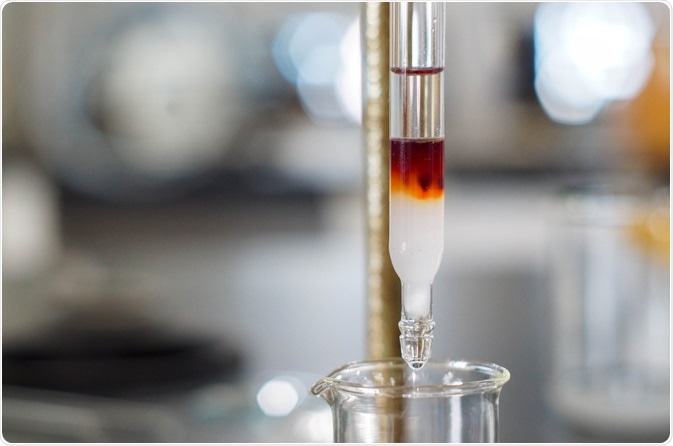Matching chromatography columns in two-dimensional liquid chromatography largely depends on the experience of the experimenter. Recently, scientists in the US have developed a computational tool to select suitable column combinations based on physicochemical properties of the column phases, and the analytes that shall be separated.
This article will cover:
 Satienpong P | Shutterstock
Satienpong P | Shutterstock
What is 2D liquid chromatography?
Two-dimensional (2D) liquid chromatography is a powerful tool to separate complex compound mixtures.
The principle behind 2D liquid chromatography is that compounds in a sample are separated by two subsequent chromatography steps, which separate the compounds based on different physicochemical parameters. For instance, the first chromatography dimension could separate molecules based on hydrophobicity (e.g. reversed-phase liquid chromatography), and the second dimension based on their charge (e.g. ion chromatography).
A 2D separation therefore achieves higher separation power in complex mixtures. With a wide selection of chromatography columns with different separation phases being on the market – such as C18, ionic, embedded polar, aromatic phenyl, and chiral phases – a large number of orthogonal physicochemical features can be selected from.
The selection of column combinations is usually largely empirical, and there is no optimal column combination for all compounds. Instead, a column selection needs to take into account which critical compounds need to be separated in a particular sample. However, the combined columns need to be matched to the 2D liquid chromatography operating conditions, such as the solvent choice.
With the aim to facilitate chromatography column combination selection for 2D liquid chromatography, scientists in the USA developed a computational model that assesses optimal column combinations for 2D liquid chromatography based on physicochemical parameters of common liquid chromatography columns and different sets of analytes.
Screening column sets for optimal chromatographic performance
The researchers used the “Snyder-Dolan Hydrophobic Subtraction Model” (HSM) to assess the interaction of different column phases with different analytes. To use this model, information about several physicochemical properties of analytes and column phases is required.
The researchers thus took 565 chromatography liquid chromatography columns into consideration for which those parameters had been experimentally determined. To extend the HSM model to 2D liquid chromatography, they ran their model for all possible combinations of these columns (i.e. 319,225 column combinations).
To predict the separation power of each of these column combinations, the researchers identified 90 compounds as test analytes where all required physicochemical parameters were known. To access a more diverse set of compounds, they computationally combined the physicochemical properties of selections from these 90 compounds into a set of 10,000 “virtual” model compounds.
For each column combination, they selected 100 combinations of 1,000 compounds sampled from the generated set of 10,000 compounds. The output of this computation was in effect a set of 100 virtual two-dimensional chromatograms with each 1,000 compound peaks for each of the 319,225 liquid chromatography column combinations.
High separation power for C18 combined with Embedded Polar phases
Screening the column combinations with their computational tool, the researchers could rank the different column combinations according to their separation power. Their study revealed that for the separation of their sets of model compounds, the best performing combinations had a prevalence for hydrophobic C18 or aromatic phenyl phases in the first dimension of the 2D liquid chromatography, and a strong prevalence for embedded polar phases – i.e. hydrophobic phases interspersed with hydrophilic functionalities – in the second dimension.
The scientists thus provided a tool to facilitate 2D liquid chromatography method development by suggesting column combinations from a wide range of column phases, based on the physicochemical properties of both an analyte set of interest and the liquid chromatography columns.
Experimental validation will now be required to determine whether predicted column phases will operate well if suggested for a particular set of analytes that an experimenter is interested in. The researchers have made their tool available online so that experimental scientists can make use of the computational tool.
Source
Lindsey RK et al., Column selection for comprehensive two-dimensional liquid chromatography using the hydrophobic subtraction model. Journal of Chromatography A. 2019, 1589, 47-55; DOI: 10.1016/j.chroma.2018.09.018.
Further Reading
Last Updated: Jul 25, 2019